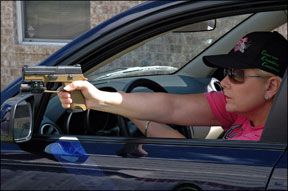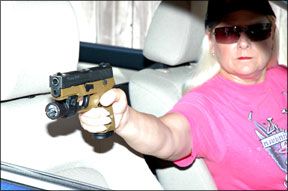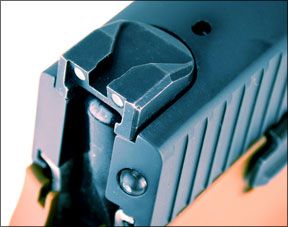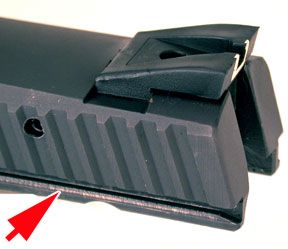During a visit to Top Gun Range in Houston, one of our favorite retail gun shops, two colorful 9mm polymer pistols caught our eye. One was the Springfield Armory XD Service Model No. XD9201HCSP06, with an olive-drab-green frame and black slide, $543. The other pistol was the SIG Sauer P250 Compact No. 2509205, with a dark-earth-colored grip and Melonite-black slide. Both of these pistols were double-action-only, but from the operators’ point of view, their unique triggers gave each gun a different personality. A comparison test was in order but we wanted to add a third pistol. That’s when we found a new model from CZ USA that was also a polymer 9mm semiautomatic. The CZ USA P-07 Duty arrived as a DA/SA, traditional double-action pistol. But the P0-7 was also shipped with an optional set of ambidextrous thumb levers. When swapped out with the decocker levers, the P-07 could be fired single-action-only with a thumb-operated safety. We decided to focus our test on the single-action capability of the P-07 because it was the only mode in which operation of the trigger remained constant. This played into our desire to test three polymer nines, each with a different, but simplified, way to light the fuse.

For accuracy tests we fired from sandbag rests at targets placed a measured 15 yards downrange. We also staged a rapid-action test from a distance of 7 yards. For our 15-yard session we fired Black Hills 115-grain full-metal jacketed ammunition, and two choices from the catalog of Atlanta Arms and Ammo. They were the 125-grain HAP rounds and the AAA Sub Sonic 147-grain JHP Match ammunition. For our 7-yard session we fired 124-grain FMJ rounds from Black Hills. Both the 147-grain and 124-grain rounds were sold in blue boxes, signifying that they were remanufactured ammunition. During the benchrest session, our pistols were fired utilizing a controlled press with the sights on target and the gun fully supported. Our rapid-action session was performed standing in front of a Hoffners ABC16 target. The point of aim was the A-zone/chest area and the B-zone/head. The shooter began with the gun in both hands chest high. The muzzle was canted slightly upward so that the front sight was at the bottom of the shooter’s peripheral vision. The trigger finger began resting along the frame outside the trigger guard. Upon an audible start signal from a shot-recording timer, the shooter pressed the gun toward the A-zone, fired two shots then moved the sights upward to deliver one more hit to the B-zone. We took note of shot placement and recorded the elapsed time for each of 10 recorded runs. Since we were testing at Top Gun Handgun Training Center, a public indoor range which tends to be louder than an outdoor setting, we were wearing ear plugs as well as ear muffs. Taking note of the elapsed time between the buzzer and the first shot, we kept in mind the slight delay to our hearing as well as the physical manipulation necessary to deliver a first shot. Subtracting the first shot ET from the total time told us more about recoil management, trigger control and sight alignment. Happily, none or our guns showed any hint of malfunction when firing, so we were able to concentrate on the essential operation of each weapon. Here is what we found.
Springfield Armory XD XD9201HCSP06 9mm OD Green, $543
When polymer-frame guns began to dominate sales, most manufacturers hit the drawing boards and started from scratch. Springfield Armory on the other hand bought into the manufacturing of a pistol that was already proven. First imported independently as the Intrac HS2000 (see Gun Tests, April 2001), what became the XD series was already serving the Croatian police. Its key points were its short-action trigger, mechanical grip safety and outstanding ergonomics. The Olive Drab Green model is essentially a Four-Inch (barrel) Service model, that is normally black top to bottom. Our test gun did not share any of the variations in grip contour, sights, slide release, or slide profile changes similar to the newer XDM pistol (Gun Tests, March 2009).
Save for the change in color of grip frame, which we thought was striking, our test gun was the basic XD. The sights were dovetailed into place front and rear. They were clear and eminently useful. Like the other test guns the XD accommodated accessories, such as a light or laser, with a rail beneath its dust cover. The shiny stainless-steel 16-round magazines ejected smartly by pressing a release located on either side of the pistol. The slide release was left side only and once set, held the slide to rear and could not be shaken loose no matter how hard we mashed home a fresh magazine. In comparison, both the SIG Sauer and CZ pistols did at times let go of the slide when a fresh magazine was rammed into place.
Removing the top end of the XD meant locking back the slide and rotating the latch, which stayed connected to the frame. This was similar to the SIG Sauer design. The chamber had a loaded indicator that rotated upward from behind the ejection port when there was a round in place. But we’d recommend double checking the condition of the chamber before field stripping because to move the slide off the frame, the trigger must be pressed, a characteristic that’s been deleted from the design of the XDMs. Beneath the slide was a linkless barrel that locked and unlocked over a block fixed into the frame, not unlike the SIG Sauer pistols. In fact, placed side by side the barrels of all three guns appeared nearly interchangeable. All three guns had ramped barrels, and lockup points along the barrel were similar, too. We could even see the same polished areas above and below the muzzle where the front of all three barrels found support.

The trigger had a safety lever that was placed inside the face of the trigger just like the Glock pistols, achieving the same result as the Safe Action system. The grip safety was a second safety feature that required compression, but there was no active mechanical safety or decocker.
At the range we began by shooting groups with the Black Hills 115-grain FMJ ammunition from a sandbag rest. The XD pistol never malfunctioned, but we did notice a problem that seemed to regulate itself after a couple of hundred rounds. We found we could load six rounds and print a five-shot group measuring between 1.1 and 2.0 inches firing the Black Hills ammunition. But this measurement would be ignoring the placement of the first shot, which regularly hit the target about 2 inches lower than the others. This is often attributable to hand-cycling the first round into the chamber, which produces a different lockup than is achieved by firing the weapon. Our best effort to confirm this was to load six rounds into the pistol and fire the first shot off target into the berm. Then we proceeded to fire five shots on target and measure the resulting group. We found this procedure helped us avoid a flyer. But by the time we began firing the 125-grain HAP rounds from Atlanta Arms and Ammunition, which seemed to cycle the slide at a higher rate of speed, we were no longer suffering a pattern of a tight group with a lone flyer. Whatever was preventing the slide from locking up properly had now been polished off, and the bearing surfaces were now mating correctly.
Firing the 125-grain ammunition, we shot groups that measured an average of about 1.8 inches. The much-lower-velocity 147-grain ammunition from Atlanta Arms and Ammunition produced an average group of about 1.9 inches. After our unintended break-in regimen, we revisited the 115-grain Black Hills Ammunition and averaged 1.5 inches for five-shot groups.
Our rapid-action test was performed indoors in moderate light on a separate day from our bench session, which was performed at an outdoor range in bright sunlight. We tested one gun after another in the same time period. Since each gun was so different in terms of trigger control, we assumed that a practice set of ten runs would be necessary for a warm up. But the XD made it easy for us to open our session with what amounted to ten near perfect runs out of the box. We had all 20/20 shots grouped into the A-zone and just three shots high or low of the B-zone for a score of 7/10, which covered little more than the area from the upper lip to the eyebrow of the Hoffners silhouette target. We would attribute this to the natural grip of the XD pistol. Overall elapsed time averaged about 2.25 seconds. Deducting the average delay before the first shot was fired, we found that three accurate shots could be delivered within 1.25 seconds.
Our Team Said: Color enhancement can only add to this proven workhorse that is perhaps the easiest handgun to learn to shoot accurately. Even after shooting the other pistols, we could produce high scores in our rapid-action test. Initial irregularity from the bench could warrant a downgrade, but break-in seemed to improve this pistol.
SIG Sauer P250 Compact No. 2509205 Flat Dark Earth 9mm, $795
Aside from the introduction of a new 380-caliber pistol, the P250 series is the latest innovation from SIG Sauer, formerly known in the United States as Sigarms. The hallmark of this pistol is its modular design. Most pistols consist of two sections consisting of a receiver or, bottom end, which houses the magazine and trigger assembly, and a top end that houses the barrel and reciprocating slide. But the P250 pistols consist of three separate assemblies. The top end remained the same, housing the barrel, recoil assembly, extractor, ejector, and firing pin. Instead of riding directly on a frame that is one piece with the grip along with the trigger guard, dust cover and magazine well, this part was separate from the machinery that does the work of firing and cycling the action.

The modular design concept is not new. Many pistols made by Taurus, STI and SVI are constructed in much the same way. It’s just that the lower end of these handguns cannot be swapped quickly and easily or, without mixing the serial numbers of two different weapons.
Not unlike the separation of a barreled action from a rifle stock, the polymer grip frame, or module as SIG Sauer prefers to call it, cloaks the working parts. Rather than merely offering alternative size and shape sections of the grip, the P250 offers entire modules of sizes small, medium, and large to accommodate different size hands. It is important to note that the grip modules are not serialized. The middle section that houses the firing mechanism is the gun. A window cut into the side of the polymer grip module displayed the serial number. So, one could own several different grip bodies of different size and shape, but in the eyes of the law, be in possession of a single gun.
Our Flat Dark Earth P250 was a dealer special in limited quantities. The price we listed was a dealer estimate. The color was a limited edition. Ours arrived with only one 15-round magazine (made in Italy). Extra magazines cost $45, but according to a representative at SIG Sauer, as of June 4, 2009, this pistol will be shipped with two magazines.
SigLite night sights were standard. The front sight was dovetailed into place, but the rear unit was low mounted into a relief in the slide. We trust that the centering of the rear sight was perfect because there is no way to move it from side to side. You could adjust the elevation by changing the height of the front blade, but mounting of the rear sight permanently ends the argument over whether the gun is sighted in to the left or right. But the sights were very clear to our eyes and we liked the color of the frame. Other features included an accessory rail with three cross hatches and ambidextrous slide release.
Aside from the modular construction of the P250, the double-action-only trigger is another unique feature. SIG Sauer offers pistols with single-action-only sliding triggers, single-action-only hinged triggers, traditional-double-action triggers with standard and short return (SRT), the DAK system and the mechanism found on the P250. From the shooter’s point of view, the P250 system is probably closest to the DAK trigger in feel, but the length of travel found in the P250 is much longer, with zero change in resistance throughout the duration of the pull. There is also a one-to-one ratio of movement between the hammer and the trigger. You can almost see how the movement of the trigger mirrors the movement of the hammer. This system provides one of the smoothest triggers we have found.
At the range we began with firing from a rest utilizing a controlled press. Since the travel of the trigger to the point of ignition was so long, we found it natural to stage the trigger. That is, we paused our stroke for a final sight alignment. This rewarded us with stellar groups that were directly to point of aim. The SIG favored the Black Hills 115-grain FMJ rounds, delivering groups ranging in size from 0.9 inches to 1.4 inches. The hotter 125-grain rounds from Atlanta Arms and Ammo printed the largest groups, averaging about 2.2 inches. We found that the P250 was prone to muzzle flip, and we might credit this lesser performance to the higher slide velocity produced by this round. The 147-grain Sub Sonic rounds were lazy in comparison, and this seemed to help our shooting. We think the improved control allowed us to print groups measuring about 1.4 inches on average. Along the way we noticed that when the magazine was empty, the slide did not lock back consistently.

Before attempting our action test, we wondered if the long trigger pull would result in the P250 being slower than the other pistols. Our practice runs began with elapsed times in the 2.80-second range, but according to the timer, our first shots were not necessarily slower. Ready for scores of record, our first run measured 2.50 seconds in total with a 1.00-second first shot. Our best single run was completed in 2.24 seconds with a 0.85-second first shot. But we found after just this brief session that a 2.40-second run with a first shot coming about 0.95 seconds after the start signal could guarantee accurate hits. That’s three accurate shots over a period of about 1.45 seconds on average. Trying too hard we recorded a 1.72 second run, but the first shot broke at 0.77 seconds out of control. This shot joined three more shots outside the A-zone, but grouping in the head area was quite good. In this way we learned that even though a shooter could change his mind and back off the trigger without jamming the gun or leaving it half cocked, the point of no return was not easily found. The P250 trigger was so smooth that playing the game of taking up the trigger could be a deadly one. Unlike a revolver that shows you a rotating cylinder or trigger with a defined take-up, we think developing a smooth, continuous stroke of the trigger is the best advice.
Our Team Said: Its smooth trigger sets it apart from other double-action handguns. Most people will find the P250 a cinch to shoot accurately. But the length of its stroke with little feedback requires special training to build speed and ensure safety. The P250’s propensity for muzzle flip may be its only weakness.
CZ USA P-07 Duty No. 91186 9mm, $508
The P-07 Duty is advertised as having a totally new trigger system referred to as the Omega. What sets the Omega system apart from previous designs is fewer total parts and rapid conversion from traditional double action with ambidextrous decocking levers to single-action capability with ambidextrous thumb safeties. In single-action mode the P-07 can still be fired DA/SA, but without a decocker the hammer can only be lowered manually. The polymer frame is also a totally new design, and so is the contour of the slide.
The P-07 Duty is sold in only one color, black, but that doesn’t prevent it from being striking and futuristic in its appearance. Some of the visual highlights were functional, too. The matte-black finish was broken up with dark textured areas to provide enhanced grip. The side panels were knurled and so was a patch on both sides of the frame just ahead of the slide stop pin. This patch can make the gun easier to work on or as a tactile cue for resting the finger when off the trigger. The trigger guard was square at the front, and it was grooved for grip in case you are one of the old-guard shooters who still grip the gun with their weak-hand index finger extended and wrapped around the trigger guard (apologies to all-time great IPSC shooter and now top military/LE trainer Jerry Barnhart). The slide, which rode upon rails facing inside of the frame in true CZ fashion, had been artfully sculpted to save weight and reduce recoil. The web of the shooter’s strong hand was buried deep into a recess at the top of the grip. The sensation of the hand being part of the gun was enhanced by a static beavertail that looked like it belonged on a custom 1911.
The CZ pistols are renowned for their ergonomics, and we found the P-07 to be especially accommodating to our hands. It actually reminded us of the Springfield Armory XD pistol which is only fair because some people see the XD grip as borrowing from the CZ 75 to begin with. The result is that whether fired single-action-only or shot beginning with a double-action pull, the gun offered a very stable grip. No one on our staff was tempted to change his hand position to accommodate the difference between the double- and single-action pull.
The sights on the P-07 Duty consisted of a front blade that was pressed into a channel from the muzzle end. Its face was enhanced with white paint up and down in a rectangle that reached to all the way to the tip of the blade. This was effective on darker surfaces, but to better define the top edge of the blade we blacked out the tip, leaving a small white square.
The rear sight was a fixed unit, so we assume elevation could be changed only by mounting a front sight blade of different height. But we found no need to change elevation, nor were any alternate front sights provided. The rear sight was snag free with a sweeping profile and placed the notch fully at the rear of the slide for maximum sight radius. It was dovetailed into place, but due to the way it was pinned, we’re not sure how amenable it would be to being adjusted with a drifting tool.
Removing the top end of the P-07 required pulling the slide back about one-quarter inch and removing the slide stop pin. The tip of the slide-stop pin was flush with the right side of the frame and beveled to accept a small punch or the corner of the magazine base pad, as was recommended by the owner’s manual. The advantage of a flush-set pin is to avoid any possibility of it being pushed inward accidentally and possibly stalling the action. With the safety off and hammer in the half-cock position, the slide can now be removed.
Beneath the barrel we found a flat wound recoil spring that, unlike on our other two pistols, was not captured on the guide rod. The recoil spring was quite long and resistant, making reinstallation challenging. With the top end removed, the shooter could now make the choice between TDA with a decocker or single-action-only with the option of manually decocking. The gun arrived in TDA mode, but we changed to single-action fire. This was accomplished by doing little more than pressing down on the ejector and the trigger bar while removing the decocker levers and a single spring. The safety levers were installed in the reverse process, but without the spring.
Accuracy data was collected firing single-action-only. The SA trigger produced 4.5 pounds of resistance. The feel of the trigger was a smooth soft compression, not crisp like breaking glass but not mushy, either. There was the slightest bit of creep, but no hint of grit or drag.
Overall, the CZ was the most consistent performer from the bench. That it produced the best single group of the test (0.8 inch firing the Black Hills ammunition) was not necessarily more impressive than how it performed with all three test rounds. Group size firing the 125-grain HAP rounds ran from 1.4 inches to 1.7 inches. Shooting the 147-grain Sub Sonic Match hollowpoints, group sizes measured, 1.0, 1.1, 1.2, 1.2, and 1.4 inches wide.
Intent on sticking to our comparison of three guns with but one mode of fire, our rapid-action test was performed single-action-only. But we did try firing the P-07 in traditional double-action mode, decocking both by operating the levers, and after removing the decocker, lowering the hammer by hand. In both cases we judged the double-action trigger to be a little sticky, certainly not as clean as the double action found in the CZ 75 models we recently tested. Frankly, from the time we acquired the P-07 we thought it was better suited for full time single-action fire. That the gun could still be operated double action could be a plus, however. For example, if a round did not ignite, the gun was still capable of striking the primer repeatedly from the hammer down position.
Results from our rapid-action test showed just two hits barely left of the A-zone (18/20), and three shots grouped less than 1 inch low of the B-zone (7/10). Total elapsed times for our ten runs ranged from 2.24 seconds to 2.57 seconds for an average of 2.40 seconds. But the all-important first shot time was consistently the fastest of all three guns.
However, this would probably not be the case for everyone. Some of our staff had to change grip position slightly to lower the safety. No one had difficulty raising the safety lever, but to perform our action test we had to turn the gun over to a shooter who had a longer thumb. A telephone call to CZ USA directed us to the czcustom.com website. That’s the shop that has been developing enhancements for CZ pistols, enabling them to win major Practical Shooting championships on an international level. Trigger and safety parts are currently available for other models, and supplying a set of thumb safeties for the P-07 Duty should be right up their alley.
Our Team Said: Whether used as a traditional-double-action gun or full-time single-action-only with DA as a backup, the thumb levers should be made more accessible and easier to operate. If the levers should suit your hands as they are, you should upgrade it to at least B+ for its accuracy and speed.
0809-POLYMER-ACCURACY-CHRONO.pdf
0809-SPRINFIELD-XD9-SERVICE.pdf




























